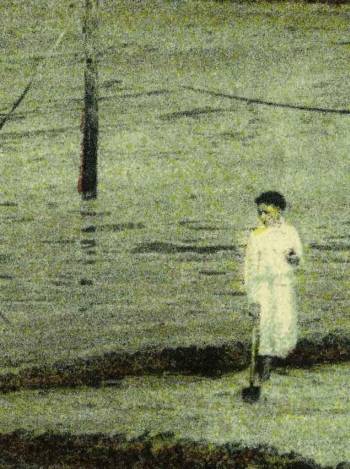Elger Esser
04 Mar - 15 Apr 2006
ELGER ESSER
March 4 – April 15, 2006
Following his Normandy series “Cap d’Antifer-Etretat” of 2002, in which Elger Esser walked the literary trail of Flaubert and Maupassant, the forthcoming exhibition of the works of Elger Esser at the Rüdiger Schöttle Gallery will be showing a further cycle of sea and beach motifs from the French Atlantic coast. These new works are based on old postcard motifs from the artist’s own long-standing, comprehensive collection of landscape photographs by anonymous photographers from the early years of photography. Historical landscape photography is one of Elger Esser’s central themes. The original picture postcards date from the period from 1900 onwards and were printed by the Parisian publisher Lucien Levie (LL) in photogravure or copper gravure and then largely coloured. Esser enlarges these old-fashioned, romantic motifs from the pioneering days of tourism to such a degree that their characteristically very fine grain is quite visible. Thematically, Esser’s works refer to the early days of photography in the art historical context. In this sense, they are also reminiscences of Impressionism, a movement in art which, parallel to the discovery of photography, was largely concerned with the phenomenon of light, a phenomenon which also has an important part to play in Esser’s own landscapes.
The photographer Elger Esser always sees the history of photography in both a literary and an art-historical light. The picture postcard was the first mass-produced photograph and may be considered as one of the very first examples of “democratic” photography. The picture postcards from those early days of tourism both captured and reflected memories, moods and feelings of universal validity. A picture postcard, chosen and posted, established a rapport, an identifying moment, between the sender and the addressee.
Esser’s photographs do not document, but rather translate the traditional notion of landscape into contemporary imagery using modern photographic and enlarging techniques. While the atmospheric landscapes chosen by Esser rarely depict people, at the most a solitary stroller, they quite literally fill the picture space with sea and sky, affording the viewer all the space he needs for the projection of his own feelings and thoughts.
Born in Stuttgart in 1967 and brought up in Rome, Elger Esser belongs to the youngest generation of Becher students at the Düsseldorf Art Academy. Whilst this is clearly evidenced by the documentary character of many of his series of photographs, Esser’s lyrical, atmospheric style differs strongly from the severe, matter-of-fact style of his teachers Bernd and Hilla Becher.
March 4 – April 15, 2006
Following his Normandy series “Cap d’Antifer-Etretat” of 2002, in which Elger Esser walked the literary trail of Flaubert and Maupassant, the forthcoming exhibition of the works of Elger Esser at the Rüdiger Schöttle Gallery will be showing a further cycle of sea and beach motifs from the French Atlantic coast. These new works are based on old postcard motifs from the artist’s own long-standing, comprehensive collection of landscape photographs by anonymous photographers from the early years of photography. Historical landscape photography is one of Elger Esser’s central themes. The original picture postcards date from the period from 1900 onwards and were printed by the Parisian publisher Lucien Levie (LL) in photogravure or copper gravure and then largely coloured. Esser enlarges these old-fashioned, romantic motifs from the pioneering days of tourism to such a degree that their characteristically very fine grain is quite visible. Thematically, Esser’s works refer to the early days of photography in the art historical context. In this sense, they are also reminiscences of Impressionism, a movement in art which, parallel to the discovery of photography, was largely concerned with the phenomenon of light, a phenomenon which also has an important part to play in Esser’s own landscapes.
The photographer Elger Esser always sees the history of photography in both a literary and an art-historical light. The picture postcard was the first mass-produced photograph and may be considered as one of the very first examples of “democratic” photography. The picture postcards from those early days of tourism both captured and reflected memories, moods and feelings of universal validity. A picture postcard, chosen and posted, established a rapport, an identifying moment, between the sender and the addressee.
Esser’s photographs do not document, but rather translate the traditional notion of landscape into contemporary imagery using modern photographic and enlarging techniques. While the atmospheric landscapes chosen by Esser rarely depict people, at the most a solitary stroller, they quite literally fill the picture space with sea and sky, affording the viewer all the space he needs for the projection of his own feelings and thoughts.
Born in Stuttgart in 1967 and brought up in Rome, Elger Esser belongs to the youngest generation of Becher students at the Düsseldorf Art Academy. Whilst this is clearly evidenced by the documentary character of many of his series of photographs, Esser’s lyrical, atmospheric style differs strongly from the severe, matter-of-fact style of his teachers Bernd and Hilla Becher.

